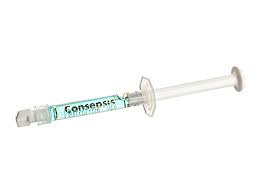Endodontic Uses
Consepsis is recommended for procedural endodontic disinfection, as a final endodontic rinse prior to canal obturation,1–3 and prior to pulp capping. Consepsis should be used after smear layer removal for canal disinfection. Sodium hypochlorite and EDTA solutions should be rinsed and removed prior to using Consepsis.
Note: DO NOT mix Consepsis (or any chlorhexidine solution) and ChlorCid®(sodium hypochlorite) in the canal as a harmful brown precipitate will form.
Bonding Uses
Consepsis is a 2.0% chlorhexidine gluconate solution free of emollients that interfere with bond strength.
Minimize post-op pulpitis and sensitivity by thoroughly cleaning and disinfecting the preparation prior to sealing and restoring. Use prior to crown cementation, luting (provisional and/or permanent), and direct restorative placement, as well as procedural endodontic disinfection. During pulp capping, acidic etchants and hemostatic agents can cause disastrous effects on the pulp. Disinfect with near-neutral Consepsis, which can also be used to passively control nonhyperemic bleeding.
Use Consepsis prior to DBA application to disinfect root surface with sensitive root treatment or when bonding.
INDICATIONS:
Consepsis is recommended for procedural endodontic disinfection, as a final endodontic rinse prior to canal obturation, and prior to pulp capping. Consepsis should be used after smear layer removal for canal disinfection.
Consepsis can also be used to thoroughly clean and disinfect the preparation prior to sealing and restoring. Use prior to crown cementation, luting (provisional and/or permanent), and direct restorative placement, as well as procedural endodontic disinfection. It can also be used to passively control nonhyperemic bleeding.
Clinicals
Disinfect Preparations
/Endodontics/Consepsis/1_Consepsis-Clinical_Disinfect-Prepartions.jpg)
?Disinfect preparations by applying Consepsis with the Blue Mini® Dento-Infusor® tip or Black Mini® Brush tip.
Disinfect Canals
/Endodontics/Consepsis/2_Consepsis-Clinical_Disinfect-Canals.jpg)
?Use Consepsis to disinfect canals during endodontic procedures, or as an interappointment intraoral medication.


